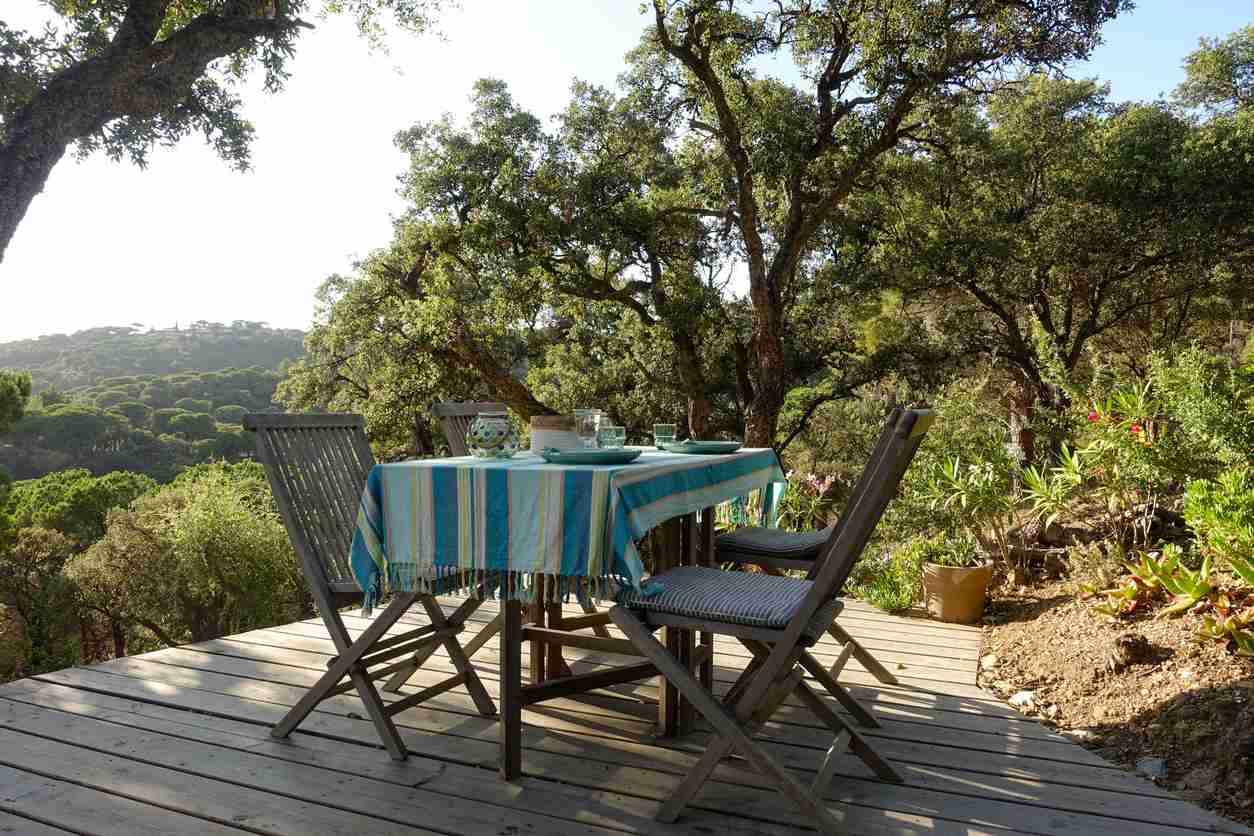
Building a terrace: where?
Are you still unsure about where you are going to build your terrace? Here are three important points to guide you towards the right choice:
- The orientation of your terrace: When do you want to enjoy your outdoor space? Are you more shade or sun? Are you going to favor a south-facing terrace? What winds will your terrace be most exposed to? What is the best exposure for your terrace? These questions are crucial because they will determine the choice of your covering.
- The surrounding vegetation: Will the surrounding trees shade you in the middle of summer? Are certain trees likely to get in the way or lose their leaves come fall on your terrace? Or even fruit?
- Easy access: From which room in your house will you access your terrace? The kitchen ? The living room ? From the outside only? If you dream of having dinner or lunch outside, thinking about access in advance is important.
What are the different types of terraces?
The style of your terrace will depend on several things: your taste of course, but also the configuration of your land and the appearance of your house. Also, take into account the view, the panorama that you could have, depending on the style of terrace you choose.
- The adjoining terrace: Also called a single-storey terrace. It will be built at the same level as your home. Its access is easy.
- The raised terrace: Depending on the slope of your land and the location of your openings, a raised terrace of at least 60 cm will be a beautiful outdoor arrangement. Ideal for sloping terrain.
- The roof terrace: Vegetated or not. This is the type of terrace that can be found in very contemporary homes. Pay attention to waterproofing!
Wooden terrace or composite terrace?
The authenticity of wood for your terrace
As wood is a natural material, it gives your terrace the elegance and authenticity that we all appreciate. Its installation and cutting are easy. It is a material which has the advantage of being easy to work with to meet the highest requirements.
That said, if you don’t like to maintain your terrace, the wood will need to be repainted, stained or oiled to maintain its beautiful shine and not turn gray.
Also, as wood works, it is necessary, during assembly, to take into account the expansion in length and width. The wood must have enough room to work with.
The ease of a composite terrace
Unlike wood, composite does not require maintenance. Brushing with soap is enough to restore its original appearance. The composite does not work and is resistant to humidity and frost. It does not become slippery when wet. Its resistance gives it a long lifespan: most manufacturers can guarantee it for 25 years.
Be careful to choose a good quality composite, otherwise it will have a plastic appearance. Which is a departure from the charm of the wooden terrace. If you live in an area where the heat is high, be aware that the composite of your deck conducts heat, unless you cover it or create shade with a few trees.
What is the ideal size for your terrace?
First of all, your budget and the place where you want to place your terrace will determine its size. That said, here are some basic rules that will help you in your choice:
- Minimum size: To be able to move around a medium-sized table with ease, we recommend a 3 meter wide terrace.
- Comfort terrace: You have a medium-sized table and four chairs, so allow for a terrace area of 5 to 10 m2. If your table is large, allow between 10 and 15 m2.
- Living terrace: Do you imagine your terrace as a living space in its own right? A place to eat your meals, prepare and cook your barbecue, provide children’s games and deck chairs to relax? We recommend a terrace with a minimum surface area of 20 m2.
Covering: how to choose materials?
It is your personal taste that will decide which of these four materials you will favor:
The wooden terrace
In slats or slats, wood is an economical material for designing your terrace since you do not need to do earthworks to install the pedestals. We return to its natural, authentic and elegant appearance which will bring charm to your terrace.
The concrete terrace
Concrete is a strong and durable material that requires almost no maintenance. Inexpensive, you can personalize it with paint or by making deactivated concrete, which will add relief.
The stone terrace
Just like wood, stone brings immediate charm to your home. Even if it remains expensive, stone is an investment that you will keep for years, without altering its appearance. You have a wide choice of colors and textures: sandstone, marble, slate, or the stone of your region.
The tiled terrace
The tiles are solid and have a long lifespan, provided they are cleaned with non-abrasive products. You have an endless choice of patterns and colors to match the design of your home.
What are the administrative procedures for building a terrace?
The administrative procedures are not the same depending on the type of terrace. Contact your town hall to find out the PLU (local town planning plan) for your area. You will thus know the obligations for the footprint and the choice of materials.
For a single-storey terrace
No administrative formalities for a single-storey terrace since it is not seen as a footprint.
For a raised terrace
From 60 cm above the ground, your terrace is considered raised. Covered or not, it is subject to the same rules as a single-storey terrace.
For a roof terrace
Given that the roof terrace is located on an already existing construction, it is considered that there is no additional footprint, so there is no action to be taken.

